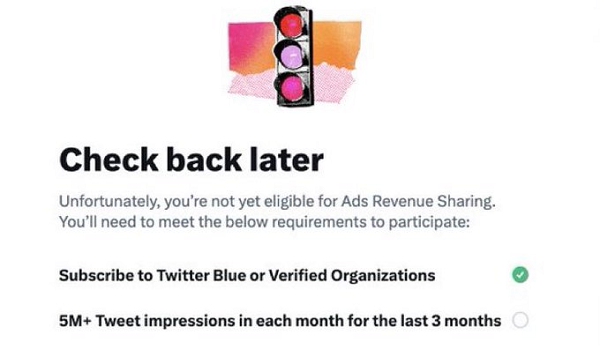Twitter’s new ad revenue share program for tweet replies is getting closer to launch – though the qualifications for monetization, as displayed in the latest welcome screen for the offering, are likely to put most users out of the running to make money from their tweet content.
Last month, Twitter owner Elon Musk announced that, soon Twitter Blue subscribers would be able to sign-up for a share of any revenue generated from ads shown to other verified users in their tweet responses.
In a few weeks, X/Twitter will start paying creators for ads served in their replies. First block payment totals $5M.
Note, the creator must be verified and only ads served to verified users count.
— Elon Musk (@elonmusk) June 9, 2023
As you can see, Elon announced that this would be available ‘in a few weeks’ about a month ago, so the expectation is that this is coming any minute. And based on this new screenshot, shared by T(w)itter Daily News, the entry requirements for tweet monetization will be high.

The current requirements, as noted in this new entry screen – which, it’s important to note, has not gone live as yet, so it may change. But as of right now, the entry requirements for the new tweet reply monetization program will be:
- An active subscription to Twitter Blue/Verification for Organizations
- Five million or more Tweet impressions in each month for the last three months
Which is a massive amount of engagement – very few highly active Twitter accounts would be reaching this level of activity.
Though, for those that are, they could well make some good income from the program, as anyone getting 5m+ impressions is likely to be seeing a lot of replies, and thus, a lot of opportunity for ad exposure.
It’s impossible to calculate, at this stage, what exactly users could expect to earn from the program, but it could see the top creators in the app making a significant income – which might also be the initial aim, in having these big users share their revenue share success in the app, which would then inspire more users to aim for these higher engagement thresholds, in order to get their own piece of the pie.
Though that, in itself, could be fraught with danger.
By incentivizing engagement, Twitter will also, in turn, be pushing users to share more incendiary, divisive tweets, in order to spark more responses, and increase your potential for more ads to be displayed in reply chains.
Research shows that high arousal emotions, like anger and happiness, are the key drivers of comments on web posts, with negative emotions driving more virality – meaning that the best way to maximize the amount of comments and replies is to post things that make people angry enough to respond.
By setting the engagement thresholds so high, there’s really no way for people to get that type of response, unless they’re either an established celebrity, with an active fan base, or they’re posting comment-triggering content.
Again, that could be the aim, in getting more high-profile users to tweet more often, with a direct revenue incentive, but for smaller creators, it’s going to be a tough ask to meet these levels.
It could still change, and Twitter could review and update these thresholds over time, so this may be just a starting point. But it doesn’t look like it will be open to all, at least at this stage.



